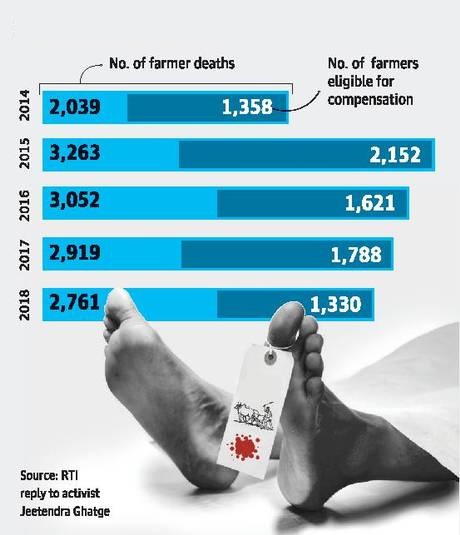On Friday past, the Maharashtra government announced in the state assembly in response to a RTI query that 12,021 farmers have died in the state from suicide in the last 4 years (between 2015 & ’19). This despite the state doling out >Rs 19,000 crore in the same period on farm loan waivers. In the first 3 months of 2019, 610 farmer suicides have already taken place.

While the number of farmer suicides have come down post 2015, they still remain sizable and does bring in the question of transparency in disbursal of funds allocated for farmer relief, not just in Maharashtra but across the country. There have been multiple reports by National Crime Records Bureau (NCRB), alleging irregularities in relief administration with money suspected to be going to producers and dealers of seeds & fertilizers rather than farmers. In 2017, Rs 35000 crore of loans & subsidies were distributed in New Delhi and Chandigarh – cities that do not have any farmers.
In India, the reliable source of farmer suicide statistics has been the NCRB which has published such stats regularly from 1995 to 2015. The 2015 figures reveal high concentration of farmer suicides in the 6 states of MP, Chhattisgarh, Maharashtra, Karnataka, Andhra & Telangana.

According to the same report, Bankruptcy or indebtedness is the biggest reason for farmer suicides – with this accounting for 79% of cases in Karnataka in 2015. And contrary to popular belief, in 80% of these cases (bankruptcy) – loans were taken from banks/registered micro-finance institutions and not local money lenders.

An independent research paper from Springer International that analyzed farmer suicides in India from 1995 to 2011 found a close empirical relationship between drought and farmer suicides. This is supported by the high number of suicides in Vidarbha (5214) and Marathwada (4699) regions of Marathwada in the last 4 years – accounting for almost 83% of all suicides in the state in the same period. Maharashtra has been one of the most drought affected states in the country in recent times. And while 2018 saw a good monsoon in the state after 3 years of drought, the current year has again raised serious concerns with delayed onset of the monsoon keeping economic observers on the edge. Steadily depleting ground water levels are a reality – According to the Composite Water Management Index (CWMI) report released by the Niti Aayog in 2018, 21 major cities (Delhi, Bengaluru, Chennai, Hyderabad and others) are racing to reach zero groundwater levels by 2020, affecting access for 100 million people. In fact, 12% of the country is already facing this “day zero” scenario, the report states. This has led to the newly elected union government forming the Jal Shakti ministry, aimed at tackling water issues with a holistic and integrated perspective on the subject.
The scenario is grim and extremely challenging. If the monsoon remains sub-par this year, it will hit the farm sector severely and lead to unimaginable stress on the already pressurized agrarian community. Effective management of water resources and maximum transparency in farm aid disbursal is the need of the hour – all eyes will be on Union Budget 2019 regarding what the new government delivers in this regard.